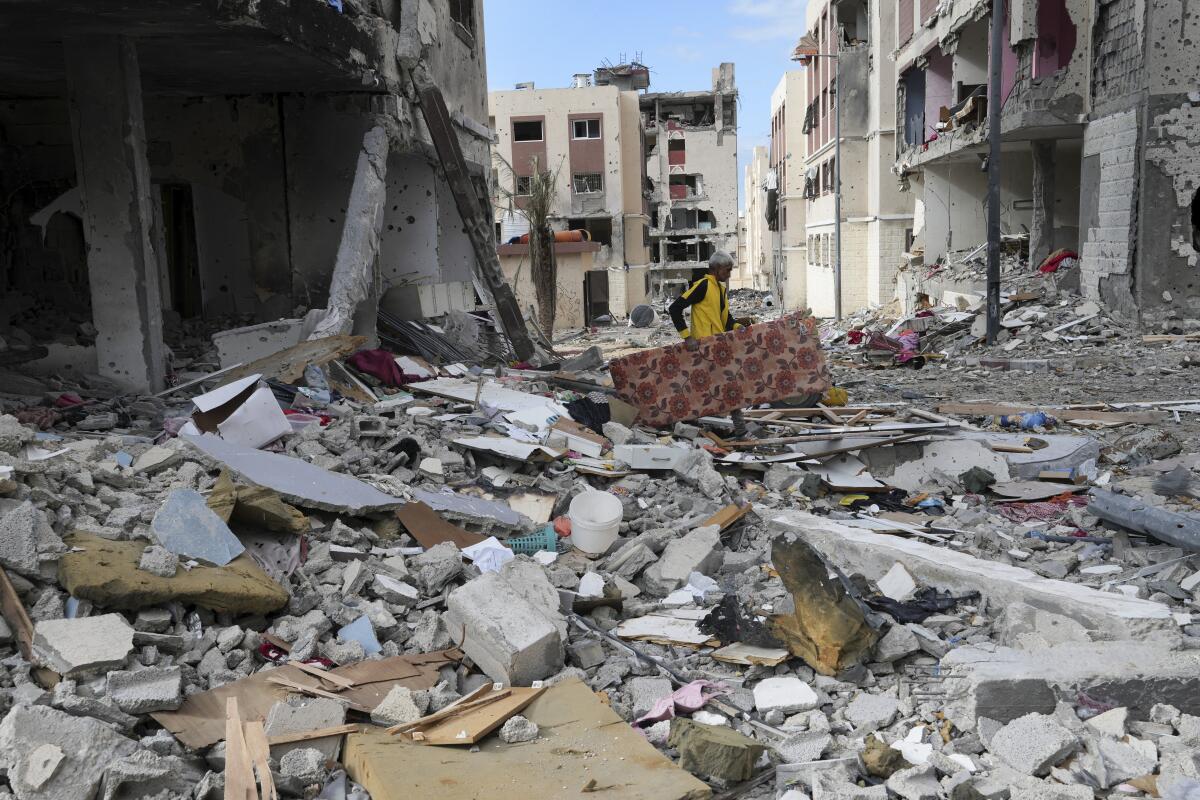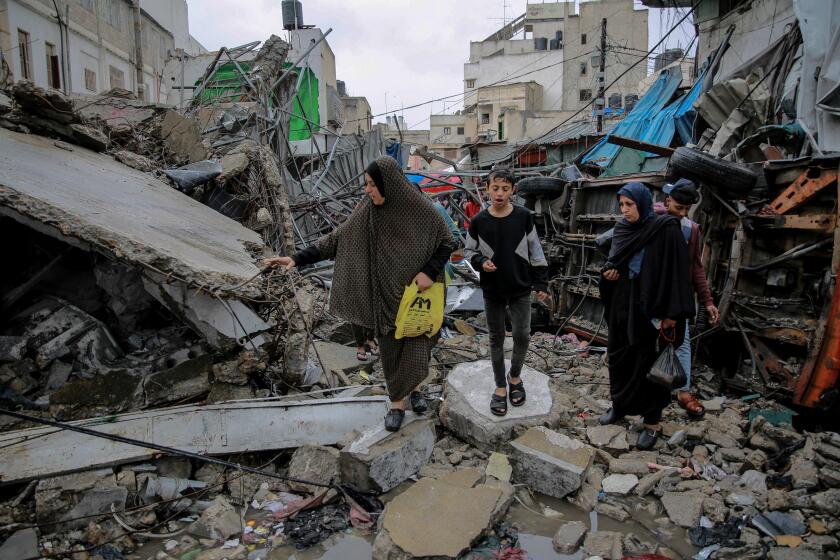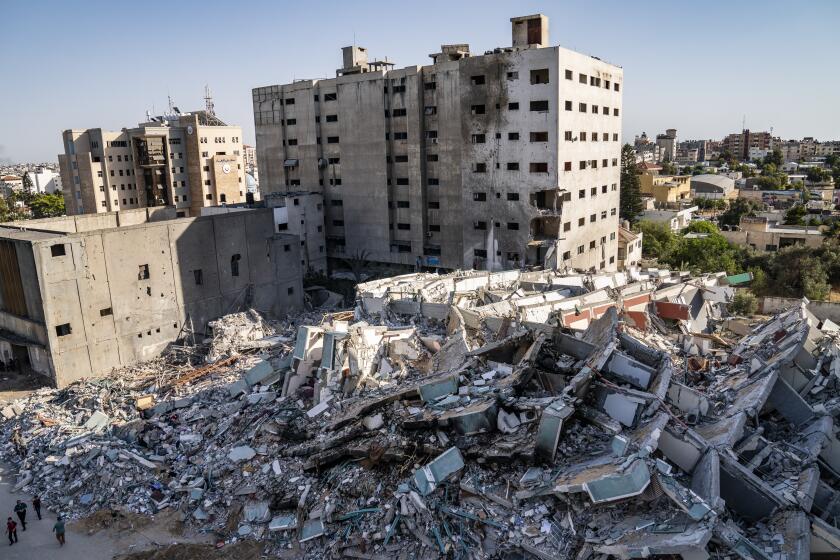Fake babies, real horror: False AI-generated images of the war in Gaza spark alarm

WASHINGTON — Among images of the bombed-out homes and ravaged streets of Gaza, some stood out for their utter horror: bloodied, abandoned infants.
Viewed millions of times online since the war began, these images are deepfakes created using artificial intelligence. If you look closely you can see clues: fingers that curl oddly, or eyes that shimmer with an unnatural light — all telltale signs of digital deception.
The outrage the images were created to provoke, however, is all too real.
Pictures from the Israel-Hamas war have vividly and painfully illustrated AI’s potential as a propaganda tool, used to create lifelike images of carnage. Since the war began last month, digitally altered ones spread on social media have been used to make false claims about responsibility for casualties or to deceive people about atrocities that never happened.
The deception is adding alarm to a war that has given rise to enough real horror on its own. More than 13,300 Palestinians have been killed in Israel’s offensive in Gaza, roughly two-thirds of them women and children, according to the enclave’s Hamas-run Health Ministry, which does not differentiate between civilians and combatants. Israeli officials say more than 1,200 people, mostly civilians, were killed by Hamas militants during their surprise Oct. 7 cross-border attack on southern Israel.
While most of the false claims circulating online about the war didn’t require AI to create and came from more conventional sources, technological advances are coming with increasing frequency and little oversight. That’s made the potential of AI to become another form of weapon starkly apparent, and offered a glimpse of what’s to come during future conflicts, elections and other big events.
Palestinians in the Gaza Strip take note of their losses and stock up on water, food, fuel and other essentials during a pause in fighting.
“It’s going to get worse — a lot worse — before it gets better,” said Jean-Claude Goldenstein, the chief executive of CREOpoint, a tech company based in San Francisco and Paris that uses AI to assess the validity of online claims. The company has created a database of the most viral deepfakes to emerge from Gaza. “Pictures, video and audio — with generative AI it’s going to be an escalation you haven’t seen.”
In some cases, photos from other conflicts or disasters have been repurposed and passed off as new. In others, generative AI programs have been used to create images from scratch, such as one of a baby crying amid bombing wreckage that went viral in the conflict’s earliest days.
Other examples of AI-generated images include videos showing supposed Israeli missile strikes, or tanks rolling through ruined neighborhoods, or families combing through rubble for survivors.
In many cases, the fakes seem designed to evoke a strong emotional reaction by including the bodies of babies, children or families. In the bloody first days of the war, supporters of both Israel and Hamas alleged that the other side had victimized children and babies; deepfake images of wailing infants offered photographic “evidence” that was quickly held up as proof.
X promises ‘highest level’ response on posts about Israel-Hamas war. Misinformation still flourishes
X, formerly known as Twitter, says it is trying to take action on hateful and graphic posts about the Israel-Hamas war. But watchdog groups say misinformation abounds.
The propagandists who create such images are skilled at targeting people’s deepest impulses and anxieties, said Imran Ahmed, chief executive of the Center for Countering Digital Hate, a nonprofit that has tracked disinformation from the war. Whether it’s a deepfake baby or an actual image of an infant from another conflict, the emotional impact on the viewer is the same.
The more abhorrent the image, the more likely a user is to remember it and to share it, unwittingly spreading the disinformation further.
“People are being told right now: Look at this picture of a baby,” Ahmed said. “The disinformation is designed to make you engage with it.”
Similarly deceptive AI-generated content began to spread after Russia invaded Ukraine in 2022. One altered video appeared to show Ukrainian President Volodymyr Zelensky ordering Ukrainians to surrender. Such claims have continued to circulate as recently as last week, showing just how persistent even easily debunked disinformation can be.
The Israeli military says that it made a “mistake” in launching a secretive influence campaign on social media.
Each new conflict, or election season, provides new opportunities for disinformation peddlers to demonstrate the latest AI advances. That has many AI experts and political scientists warning of the risks next year, when several countries hold major elections, including the U.S., India, Pakistan, Ukraine, Taiwan, Indonesia and Mexico.
The risk that AI and social media could be used to spread lies to U.S. voters has alarmed lawmakers from both parties in Washington. At a recent hearing on the dangers of deepfake technology, Rep. Gerry Connolly (D-Va.) said the U.S. must invest in the development of AI tools designed to counter other AI.
“We as a nation need to get this right,” Connolly said.
Programs to sniff out deepfakes would be of immediate interest to educators, journalists, financial analysts and others interested in rooting out falsehoods, plagiarism or fraud. Similar programs are being designed to detect doctored photos or video.
News Alerts
Get breaking news, investigations, analysis and more signature journalism from the Los Angeles Times in your inbox.
You may occasionally receive promotional content from the Los Angeles Times.
While this technology shows promise, those using AI to lie are often a step ahead, according to David Doermann, a computer scientist who led an effort at the Defense Advanced Research Projects Agency to respond to the national security threats posed by AI-manipulated images.
Doermann, who is now a professor at the University at Buffalo in New York, said effectively responding to the political and social challenges posed by AI disinformation will require both better technology and better regulations, voluntary industry standards and extensive investments in digital literacy programs to help internet users figure out ways to tell truth from fantasy.
“Every time we release a tool that detects this, our adversaries can use AI to cover up that trace evidence,” said Doermann. “Detection and trying to pull this stuff down is no longer the solution. We need to have a much bigger solution.”
More to Read
Sign up for Essential California
The most important California stories and recommendations in your inbox every morning.
You may occasionally receive promotional content from the Los Angeles Times.





![Guitar heatmap AI image. I, _Sandra Glading_, am the copyright owner of the images/video/content that I am providing to you, Los Angeles Times Communications LLC, or I have permission from the copyright owner, _[not copyrighted - it's an AI-generated image]_, of the images/video/content to provide them to you, for publication in distribution platforms and channels affiliated with you. I grant you permission to use any and all images/video/content of __the musician heatmap___ for _Jon Healey_'s article/video/content on __the Yahoo News / McAfee partnership_. Please provide photo credit to __"courtesy of McAfee"___.](https://ca-times.brightspotcdn.com/dims4/default/f4350ab/2147483647/strip/true/crop/1600x1070+0+65/resize/320x214!/quality/75/?url=https%3A%2F%2Fcalifornia-times-brightspot.s3.amazonaws.com%2F60%2Fef%2F08cda72f447d9f64b22a287fa49c%2Fla-me-guitar-heatmap-ai-image.jpg)







